| dc.description.abstract | Annuities are valued according to specified mortality and interest rate assumptions.
Should either of these rates change then the cost of providing the annuity will also change.
The subject of this project investigates the ways in which mortality-linked options could
be introduced to cover mortality risk in annuities.
It starts by outlining the historical developments on change in mortality rates, the drivers
of such change and the effect this change has on the cost of providing annuities.
Current mortality-linked capital market products are then examined to see what lessons
can be learnt by a company wishing to issue mortality-linked products.
The project then covers the ways in Which mortality options could be introduced,
deciding on two distinct types to hedge two different mortality risks.
Finally, conclusion, recommendations and limitations of the project as discussed in the
earlier sections are looked at.
Examples are provided for the main types of product envisaged as these are based upon
arbitrary alternative mortality. They primarily provide insight into the methods used rather than
the results obtained.
Mortality options are shown to reduce the variability in the issuer's results while
increasing the expected cost. Thus, they operate in a way comparable to conventional
reinsurance arrangements and should be compared with such. | en_US |

